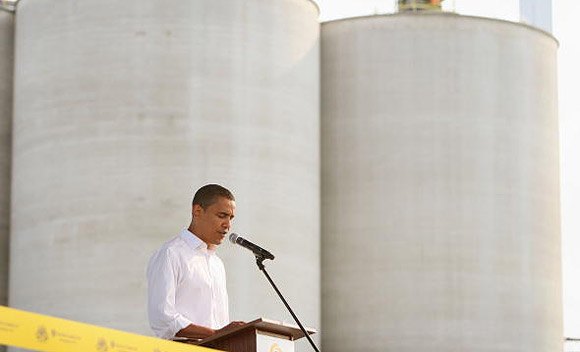E85 Boondoggle Of The Day: Obama's Corny Ethanol Science

First President Obama said the Senate may forego passing cap-and-trade, by far the most critical piece of the energy legislation that’s brewing on Capitol Hill. And now, the Environmental Protection Agency is suddenly pushing snake-oil, uh, corn-based ethanol in the latest iteration of the renewable fuel standard [ proposed rule PDF], claiming that its substitution for gasoline will reduce greenhouse gas emissions. This contradicts an earlier renewable fuel standard iteration, and most studies of the matter, including a 2008 study in Science, which found that “corn-based ethanol, instead of producing a 20% savings [as per typical life-cycle studies], nearly doubles greenhouse emissions over 30 years and increases greenhouse gases for 167 years.” [Ed: for more on the corn ethanol sham check out TTAC’s E85BOTD archives]

I'm a freelance journalist covering science, medicine, and automobiles.
More by David C. Holzman


































Comments
Join the conversation
As far as I can see (I am a Ph.D. Economist), the ethanol subsidies are completely irrational. Using taxpayer money to produce ethanol domestically - instead of buying cheap oil on the world market - is only sensible if we should face a situation of possible supply disruption. Does it make economic sense to grow broccoli expensively in your back yard when you could buy it cheaply at Walmart? There is a world market for oil out there, with diverse suppliers and producers who are economically dependent on the buyers. The risk of supply disruption is zero. What is going on here is that a strong agricultural subsidy lobby is cashing in on irrational xenophobia brought about by 9/11.
>>>If the effect is as powerful as claimed, temperatures should have risen more than they did. But when atmospheric data is looked at, the only “signal” that comes through is the increase of CO2 directly connected to the increased use of coal. I don’t know of any scientist that has yet tested the 2008 study by correlating it to atmospheric history. I don't see how they could distinguish co2 increases due to coal from those due to conversion of farmlands.
I seem to have started a minor firestorm here, but that is good. I frequently find myself having to explain agriculture from the Neolithic Revolution 10,000 year ago to the present. If there are any other farmers out there, please join in. The ethanol subsidy is given to blenders, not farmers. Farmer subsidies consist of target price support, if commodity prices are below a set point, subsidized crop insurance, and disaster aid. None of these are connected to ethanol, per se. They are available for "Program Crops," such as corn, wheat, soybeans, barley, and a few others. For farmers, ethanol is a marketing, not production, decision. It is only one of many outlets for selling a crop. Other primary outlets are the local grain elevator, livestock feeding operation, feed mills, and processing plants. Putting corn through a hog or through an ethanol plant is the same thing: it's value added processing. The residues of ethanol processing also have value. In fact, distillers grains, the high protein solid matter left over, is a highly valuable cattle feed, better than raw corn, and provides 60% of the total cattle feed value of the unprocessed corn. That makes ethanol processing a two-for. Since most corn is grown in a year by year rotation with soybeans, and since the world demand for soybeans is huge, stopping an ethanol subsidy to blenders will not change corn acreages substantially. Growing beans on beans or corn on corn is a high risk methodology, inviting plant diseases and insect infestation. It can be done for one year but cannot be maintained. Present agricultural subsidies go back to the Nixon Administration and are a result of the decision by the federal government to actively reduce grain prices to encourage export trade. In return, farmers are partially supported through periods of very low prices. The primary mechanism to accomplish this is the Commodity Credit Corporation loan rate, which establishes the value of a commodity as collateral for an operating loan and operates as a farmers' minimum wage. CCC loan rates have steadily dropped, in constant dollars. If the federal minimum wage were to have kept pace with the CCC loan rate, it would now be at around $2 an hour. The primary subsidy flow in agriculture has been from farmer to consumer, through low commodity prices, with a much smaller backflow from government to farmer. Note: high grain prices of a few years ago, the result of out of control commodity trading by entities not materially involved in commodities (made possible by the Enron Exemption), were not as high as average prices, when measured in constant dollars, in the two decades prior to the Nixon Administration. This shows the power of the CCC loan rate. As regards the green house gas emissions effect of plowing up grasslands, I think part of the problem in the discrepancy between lab studies and historical atmospheric data is that only the top six inches of soil is turned over and used for farming. However, the carbon sequestering layer underneath perennial grasses extends six to twelve feet. That stays essentially undisturbed, and the carbon remains tied up. Underground carbon storage is very stable. I agree that farming does increase production of shorter lived greenhouse gasses such as nitrous oxide and methane, but that would be the case whether the crop is consumed as food or fuel. Modern farming methods work toward retaining as high as possible a quantity of organic matter in the soil, through minimum and no till methodologies. It now takes only 50 pounds of diesel fuel to produce 10,000 pounds of corn (of course there are other energy requirements in addition). The amount of organic matter remaining in the actively farmed area of soil is dependent on climate and soil type. I've farmed on both sand and silty clay and the difference is astounding. We have had several recent events of large scale grassland conversion to farmland: the mid-20th century New Lands project in Kazakhstan and Western Siberia; plowdown of Soil Bank lands in the U.S. during the Nixon years; conversion of the Sertao in Brazil to soybean production in the last decade. We should be able to "ground proof" the lab data to these historical events. This would make an excellent dissertation research topic. While the rain forest gets a lot of attention, the largest GHG release happening right now is being nearly totally ignored, and that is the breakdown of boreal forest soils in Siberia and Canada due to scarification and exposure to sunlight as a result of logging. The largest terrestrial carbon sink on the planet is boreal soils (not trees), which sequester carbon through anoxia and acidity. Logging is allowing oxygen to enter and also methane to be released. I'd like to add one more note regarding automotive ethanol use here in Minnesota. There are now many stations (mostly in rural areas and operated by cooperatives) with pumps that allow custom blending of ethanol/gas mixtures. It would be interesting to gather real world data on blends other than E10 or E85. Sounds like a great grad student thesis. Any takers?